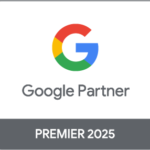Are you frustrated by the complexity of setting up a well-organized Google Ads campaign? We know how overwhelming it can be to manage keywords, ad groups, and bidding strategies. Many digital marketers struggle with chaos in their campaigns, leading to wasted budgets and poor performance.
We’ve been there too. Like many of you, we’ve faced challenges in structuring our Google Ads accounts effectively. Did you know that a poorly structured account can lead to higher costs per click (CPC) and lower quality scores? We’ve dug deep into this issue and found some reliable strategies.
In this article, we’ll walk you through creating a streamlined Google Ads campaign structure tailored to your needs. Whether you’re dealing with search campaigns or shopping ads or are interested in remarketing techniques, we’ve got practical tips for every scenario.
Stay tuned for insights that will simplify your Google Ads management!
Key Takeaways
- Organize by Keyword Match Types: Set up different ad groups for each keyword match type (exact, phrase, broad) within a single campaign. This allows precise control over bids and improves performance tracking.
- Use Custom Labels in Shopping Campaigns: Segment products using custom labels like “High Priority” or “Low Price.” This helps with better budget allocation and bid adjustments to achieve targeted ROAS.
- Segmentation in Remarketing Campaigns: Create separate ad groups based on user engagement periods, such as cart abandoners or product viewers. Tailor messages to specific audience segments for higher click-through rates and conversions.
- Avoid Splitting Error Location-Based Service Ads: Keep these campaigns consolidated unless there are specific reasons to split them. Consolidation helps maintain clearer data and more efficient management of our budgets.
- Leverage New Google Ads Features: Use the ability introduced in June 2019 to select conversions at the campaign level within one account. This offers greater flexibility when managing large accounts with varied services or products.
Overview of the article focus on efficient organization of Google Ads campaigns and ad groups
Efficiently organizing Google Ads campaigns and ad groups is crucial for better management. We will focus on teaching you techniques to maximize your ad spend and improve overall campaign performance.
Using the right structure can lead to better targeting, improved ad relevance, and higher ROI.
We will guide you through practical examples of campaign structures tailored to various niches. By mastering these strategies, you’ll become a pro at setting up Google Ads accounts that are easy to manage and optimize.
Proper organization unlocks the true potential of your Google Ads campaigns.
Call to action to subscribe for more digital marketing and web analytics tutorials
Stay ahead in digital marketing and web analytics by subscribing to our tutorials. Gain insights into Google Ads structure, PPC strategies, and effective use of data from Google Analytics.
These lessons will empower you to optimize ad campaigns, boosting your click-through rate and lowering cost per acquisition.
Join us for exclusive access to expert tips and detailed guides crafted specifically for Google Ads specialists like you. Learn how to navigate complex accounts with ease and achieve higher performance metrics through strategic planning.
Subscribe now and take your online marketing skills to the next level!
Types of Campaign and Account Structures

Different campaign and account structures cater to specific niches and requirements, offering strategic flexibility for any advertising goal.
Customizing examples based on specific niches and requirements
Different niches require unique strategies for Google Ads campaigns. For example, an eCommerce business might benefit from a structure that focuses on detailed product segmentation within Shopping Campaigns.
We would recommend setting up separate ad groups for high-margin products versus low-margin ones to optimize the return on investment (ROI). Using custom labels in Google Shopping can help us manage these segments effectively.
For service-based businesses, local targeting becomes essential. Suppose we are running ads for a home cleaning service; here, geo-targeted campaigns focusing on specific neighborhoods or zip codes will yield better results.
By tailoring our message and keywords to local audiences, we increase relevancy and click-through rates (CTR), enhancing overall performance in search engines.
Highlighting basic rules as essential across different structures
To streamline our Google Ads campaigns effectively, we must adhere to some fundamental rules applicable across all structures. First and foremost, consistent naming conventions are crucial.
Using clear and precise names for your campaigns and ad groups makes it easier to manage multiple accounts while reducing confusion. Always align campaign objectives with the chosen keywords and match types.
Organizing our keywords into tightly themed ad groups boosts relevance scores, leading to improved quality scores and lower costs per click (CPC). Implementing negative keywords at both the campaign and ad group levels prevents unwanted clicks that don’t convert well.
Regularly revisiting these basic principles ensures robust performance regardless of how complex or varied your account structures become.
Search Campaign Structures

Organize your search campaigns by setting up different ad groups for each keyword match type. This allows precise control over bids and budgets.
Example 1: One campaign with all keyword match types, divided into different ad groups
Creating one campaign with all keyword match types and dividing them into different ad groups can streamline the management process and enhance targeting. We should set up separate ad groups for exact match, phrase match, and broad match keywords.
This approach allows us to track performance more accurately and adjust bids based on which keyword type is performing best.
For instance, if we target “running shoes” as an exact match in one ad group, a phrase in another, and broad in yet another, we can see detailed data on how each performs via Google’s Keyword Planner.
Handling these separately helps fine-tune our cost-per-click (CPC) strategies for each keyword type while preventing overlap or competition within the same campaign. Next, let’s explore the benefits of using separate campaigns for different match types with exact-match negatives at the campaign level.
Example 2: Separate campaigns for different match types with exact match negatives at the campaign level
We should create separate campaigns for each keyword match type: exact, broad, and phrase. This setup helps us control our bids more effectively and see performance at a granular level.
By having distinct campaigns, we can adjust ROI strategies based on specific match types without overlapping data.
To further refine results, we use exact match negatives at the campaign level. Adding these negatives prevents cross-contamination between similar keywords in different match type campaigns.
This leads to cleaner data and clearer insights, making optimization easier while improving overall PPC structure efficiency.
Automated Bidding Campaigns: Utilizing broad match keywords without modification for target ROAS or CPA strategies
Using broad match keywords without modification is an effective way to get the most out of automated bidding campaigns. These keywords allow Google’s algorithm to identify and target a diverse range of search terms.
By doing this, we can maximize our reach while focusing on specific goals like achieving target ROAS (Return on Ad Spend) or CPA (Cost Per Acquisition).
Broad match keywords help in casting a wide net. This flexibility enables quick adaptation during auctions, ensuring our ads appear for relevant searches even if they don’t exactly match the keyword list.
Automated bidding strategies use these signals intelligently, adjusting bids in real time to hit performance targets efficiently.
Error LSA (Location-Based Service Ads) Strategy
Avoid splitting error LSA campaigns unless there are specific reasons to do so. Most advertisers will benefit from keeping these campaigns consolidated for better performance and easier management.
Recommendation to avoid splitting error LSA in most cases
Splitting Error Location-Based Service Ads (LSA) can lead to inefficiencies and wasted spending in your campaigns. Keeping LSAs consolidated helps maintain clearer data and better performance metrics.
Fewer split campaigns prevent the dilution of our budget across too many segments, allowing us to optimize ad delivery more effectively.
If we split error LSAs into multiple small-budget campaigns, it becomes challenging to manage and analyze data accurately. Instead, focusing on broader targeting within a single campaign ensures we gather sufficient data for meaningful insights.
This strategy also simplifies monitoring and adjustments, making it easier for us as Google Ads specialists to identify trends and make informed decisions swiftly.
Exceptions for low budget scenarios, remarketing focus, or long conversion funnels
In low budget scenarios, we need to make careful choices about how we structure our Google Ads campaigns. It’s often more efficient to focus on a few high-performing keywords than spreading the budget across too many.
For example, targeting broad match keywords can use up the budget quickly without guaranteeing conversions. We should prioritize exact or phrase matches in these cases.
A remarketing focus allows us to re-engage with users who have already interacted with our ads or site. This approach is cost-effective and increases conversion rates by reaching an audience that’s already shown interest in our products or services.
Long conversion funnels benefit from detailed tracking and analysis at every stage of the customer journey. By monitoring user behaviors and adjusting campaigns based on this data, we can effectively guide potential customers through each step towards making a purchase.
Large Accounts with Different Services or Products
We now have the ability to choose conversions at the campaign level within one account. This gives us more control and flexibility across different product lines or services without needing separate accounts.
Previous suggestion of separate accounts for different services or product lines
Managing large Google Ads accounts with different services or product lines often led us to create separate accounts. This approach simplified tracking and optimization, ensuring each service or product line received focused attention.
It also helped manage budgets more effectively by isolating costs and performance metrics.
As of June 2019, AdWords introduced the ability to select conversions at the campaign level within a single account. This new capability allows greater flexibility while maintaining control over distinct campaigns without needing multiple accounts.
Now, we can optimize for varied goals within one cohesive system.
New capability as of June 2019: Selection of conversions at the campaign level within a single account
As of June 2019, Google Ads introduced a fantastic new feature: selecting conversions at the campaign level within a single account. This capability lets us optimize our campaigns more effectively by tailoring which conversion actions are prioritized for each one.
Rather than having all campaigns default to account-level settings, we now enjoy greater control and precision.
This change is especially beneficial when managing large accounts offering different services or products. For instance, our search engine marketing strategy might vary between promoting an online store like Shopify and running brand awareness ads for a new product line.
By choosing specific conversion actions per campaign, we can better allocate budgets and improve performance metrics such as cost-per-click (CPC) and click-through rates (CTR).
Next up, let’s explore basic account structure examples that help target purchase-related keywords with laser focus.
Basic Account Structure Example
We start by focusing on campaigns that target purchase-related keywords. This structure ensures our ads reach the right audience, driving more conversions and improving ROI.
Core Campaign targeting purchase-related keywords with specific product or service focuses
Purchase-related keywords zero in on users ready to buy. We should target these keywords with a focus on specific products or services. This strategy narrows down potential customers, making ads more effective and cost-efficient.
Using targeted keywords helps connect us directly with the right audience. For example, focusing on “buy red sneakers” rather than just “sneakers” draws in shoppers looking to make an immediate purchase.
This produces higher conversion rates and better returns for our Google Ads campaigns.
Additional Campaigns for generic, brand, competition, and dynamic search ads
Generic campaigns target broad keywords related to our industry, driving more traffic by capturing a wide audience. For brand campaigns, we focus on keywords that include our company name or specific product names.
This ensures we dominate the search engine results page (SERP) when users look for us directly.
Competition keyword campaigns help us capture users searching for competitors’ products or services. We set up these ads to highlight what sets us apart from the competition. Dynamic Search Ads (DSA) use Google’s algorithms to match site content with relevant searches automatically.
DSAs can fill in gaps in our keyword lists and discover new profitable queries without manually updating keywords daily.
Shopping Campaigns
Shopping campaigns help us manage and segment our product ads effectively. We can use custom labels to better organize and optimize our ads for different target markets.
Advising on best practices for segmentation and management
Creating more than one shopping campaign can greatly improve segmentation and management. We should always use custom labels to organize products based on performance, category, or profit margins.
This helps us allocate budgets efficiently and focus on high-performing items.
It’s vital to segment campaigns by priority settings such as high, medium, and low. This way, we can manage our bids better by ensuring that the most important products receive more attention while keeping costs under control for lower-priority items.
Using this method allows us to achieve a higher return on ad spend (ROAS) across all segments.
Strategies for different types of campaign segmentation and usage of custom labels
Segmentation plays a huge role in managing shopping campaigns effectively. We should focus on bestsellers, average sellers, and low performers separately to optimize our techniques.
For each product group, use custom labels like “High Priority” or “Low Price” to simplify management and improve performance tracking.
We can also segment based on price range and target ROAS for more precise control. Custom labels help us tag products by their profit margins or discount levels. This enables better bid adjustments, ensuring we meet specific performance goals within our Google Ads account structure.
Remarketing Campaigns
Remarketing campaigns are essential for targeting users who have previously interacted with our site. We can create distinct ad groups based on user engagement to maximize relevance and impact.
Segmentation strategy for creating separate ad groups within a remarketing campaign
Creating separate ad groups within a remarketing campaign boosts performance and relevancy. We should start by segmenting our audience based on their engagement periods. For instance, we can create distinct groups for cart abandoners and product viewers.
Cart abandoners have already shown high intent to purchase, so targeting them with specific ads highlighting offers or reminders can be highly effective.
Meanwhile, product viewers might need more information or a different call-to-action to push them further down the conversion funnel. By dividing these segments into unique ad groups, we tailor our messages better, increasing click-through rates (CTR) and conversions.
This approach also makes it easier to track performance metrics at a granular level using tools like Google Ads Manager.
Audience segmentation based on engagement periods and against combining all remarketing lists into one ad group
Segmenting audiences based on engagement periods can provide us with clear insights into user behavior. We might target users who visited our site within 3 days differently from those who engaged 30 days ago.
This enables us to tailor messaging effectively, boosting the chances of conversion. Customized ad messaging speaks directly to each group’s current interest, making our Google Ads campaigns more efficient.
Combining all remarketing lists into a single ad group dilutes the effectiveness of our efforts. It prevents precise targeting and reduces personalization opportunities in ad copy.
Instead, creating separate ad groups for different engagement periods allows us to optimize bids and craft specific ads that resonate better with each audience segment, leading to improved results in terms of click-through rates (CTR) and conversions.
Next: Delve into basic account structure examples…
Conclusion
Properly structuring your Google Ads campaigns enhances efficiency and effectiveness. Subscribe for more tips on mastering digital advertising strategies.
Recap of the importance of a well-structured Google Ads account for easier management and optimization
A well-structured Google Ads account is crucial for easier management and optimization. By organizing your campaigns, ad groups, and keywords systematically, you can streamline the process of tracking performance metrics like Cost Per Click (CPC) and click-through rates.
This organized approach allows us to identify high-performing ads quickly, fine-tune our strategies effectively, and ultimately achieve better search results.
With an organized account structure, we can also take full advantage of automation tools available in Google Ads. Automation becomes more efficient when set up within a clean framework, allowing us to leverage features like contextual targeting or automated bidding strategies without confusion.
Segmented campaigns improve not only our productivity but also enhance the overall effectiveness of our advertising campaigns.
## Types of Campaign and Account Structures
Invitation for questions and call to subscribe for more tutorials
Taking time to structure your Google Ads campaigns simplifies management and enhances optimization. It’s crucial for us to stay connected with our community of Google Ads specialists and PPC experts.
We encourage you to ask questions in the comments below the video. Your queries help others learn and grow too.
Subscribing to our channel ensures you won’t miss out on any upcoming tutorials packed with insights into digital marketing, search engine marketing (SEM), click-throughs, and more.
Join us as we explore advanced strategies in paid search, banner ads, customer segments, and other essential topics for effective campaign management.
FAQs
1. What is the best way to structure a Google Ads campaign?
The best way to structure a Google Ads campaign is by using a hierarchical structure. Start with broad campaigns, then break them down into ad groups based on specific keywords and target audience.
2. How can we improve our landing pages for better performance?
We improve landing pages by ensuring they are relevant to the ads and have clear calls-to-action. It’s also important that they load quickly and provide valuable information tied directly to what users searched for on Google Search.
3. What role does keyword research play in a successful campaign?
Keyword research helps us understand what terms our target audience uses when searching online. This allows us to create more effective advertisements and optimize bids in CPC bidding strategies.
4. Why should we use UTM parameters in our Google Ads campaigns?
UTM parameters help track the effectiveness of different marketing services within our campaigns. They allow us to see which ads drive traffic and conversions, providing insights into customer lifetime values.
5. Can display ads be as effective as search ads?
Yes, display ads can be very effective if used correctly! They reach people across various websites, not just search results pages, increasing brand visibility through visually engaging content like video ads or banners.
6. How do geotargeting options benefit our advertising strategy?
Geotargeting lets us focus on specific locations where our target audience lives or works, making sure our advertisements appear only where they’re most likely needed—maximizing efficiency while minimizing wasted spend.











